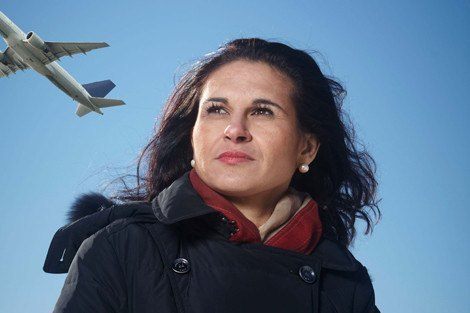[ Winter 2014 ]
Growing up, Francesca Dominici lived about a mile from Ciampino Airport, the second busiest in Rome. As she remembers it, the greatest nuisance from the roar of aircraft over her home was that she couldn’t hear her friends when talking on the phone.
Fast forward a few decades. Now professor of biostatistics and senior associate dean for research at Harvard School of Public Health, Dominici is a renowned expert in analyzing huge data sets to ferret out hidden environmental causes of disease. And her latest finding, published in October 2013 in the British Medical Journal (BMJ), has reverberated across the field.
With co-author Jonathan Levy, AB ’93, SD ’99, professor of environmental health at Boston University School of Public Health, Dominici found that elderly individuals who live along the noisiest flight paths near airports have a higher risk of being admitted to the hospital for cardiovascular disease. Specifically, she estimated a 3.5 percent increase in the cardiovascular hospitalization rate for every 10-decibel (dB) increase in airport-related noise. She also saw a strong association between noise exposure and cardiovascular hospitalizations in zip codes with noise exposures greater than 55 decibels, but no association in zip codes with exposures less than 55 decibels. (The U.S. Environmental Protection Agency defines indoor sound levels under 45 dB as acceptable; a level of 55 dB is about the same as a loud conversation.)
It’s a surprising and significant discovery. For one thing, cardiovascular diseases are the number one cause of death in the U.S. and globally. Moreover, the harmful effects of airplane noise are in the same league as other well-documented environmental hazards. Exposure to secondhand smoke in homes or bars, for example, raises the risk of hospitalization for heart disease by 4.2 percent. Two key constituents of air pollution—ozone and fine particulate matter—raise the same risk by 4.2 percent and 6.8 percent, respectively.
Dominici should know—she made all these calculations across a raft of studies since the 1990s, painting with biostatistics an otherwise unseen picture of commonplace dangers. “I like the fact that with data and rigorous mathematics and statistical methods, you can address very interesting questions that cannot be addressed otherwise,” she says. “You can tease out hidden associations.”

A short history of noise“Because their wheels clattered on paving stones, chariots in ancient Rome were banned from the streets at night to prevent the noise that disrupted sleep and caused annoyance to the citizens. Centuries later, some cities in Medieval Europe either banned horse-drawn carriages and horses from the streets at night or covered the stone streets with straw to reduce noise and to ensure peaceful sleep for the residents. In more recent times in Philadelphia, the framers of our Constitution covered nearby cobblestone streets with earth to prevent noise-induced interruptions in their important work.” Noise Pollution: A Modern Plague, Lisa Goines, RN, and Louis Hagler, MD Southern Medical Journal 2007;100(3): 287–294 |
Her latest study—the first to analyze noise exposure in large populations near multiple airports—was published alongside a separate BMJ report by British researchers, which showed that residents around London’s Heathrow Airport who are buffeted by the highest levels of daytime and nighttime aircraft noise suffered higher risks of hospitalization and death from stroke, coronary heart disease, and cardiovascular disease.
Adding urgency to the findings, experts predict increasing airline traffic, especially in countries with emerging economies and in the rising number of megacities across the globe. But public health worries about noise are not confined to the skies. Around the world, noise pollution is steadily rising with population growth, urbanization, and a flood of mobile devices.
According to Dominici, the cacophony that pervades our lives—from garbage trucks and construction to leaf blowers and wind turbines to iPods and booming car stereos—may be taking a physical and mental toll that scientists are only beginning to comprehend. The science of secondhand noise, a modern airborne pollutant, may be at the same stage as the science of secondhand smoke 60 years ago.
A beautiful meal
Traditionally, science begins with questions—around which researchers design a study, gather volunteers, collect data, and ultimately arrive at answers. Long-term Cadillac-quality studies cost tens of millions of dollars.
Dominici’s report was inspired not by a question, but by fortuitous access to two giant administrative information sets from 2009. One was Federal Aviation Administration (FAA) data on geographic patterns of aircraft noise, broken down by census block. The other was Dominici’s bank of information on more than 48 million people enrolled in Medicare, the federal health insurance program that covers some 90 percent of elderly Americans, of whom 6 million live close to a major airport. Included in Dominici’s rich data set: residential zip codes and hospitalization reports. In an era of intense competition for research dollars, the FAA offered Dominici and Levy very modest funding to figure out the best study that could be done with thin bankrolling.
“I like to make analogies with food,” says Dominici. “On the one hand, you might decide one night to cook a wonderful meal. You find a recipe and you buy the best ingredients. On the other hand, you might open the fridge, grab whatever is on the shelves—and end up with a better meal than one you might have carefully planned from the start. That’s what happened with this study. We used aircraft noise data from the FAA, health data from the Center for Medicare Services, and air pollution data from the Web—to make sure we weren’t confounding the effects of noise pollution with those of air pollution. We cooked it all together. And we came up with a beautiful meal.”
A love of numbersFrancesca Dominici traces her passion for biostatistics to a love for numbers that reaches back to childhood. Today, she specializes in separating signal from noise in big data sets—“noise,” in this case, referring to the false or irrelevant data in which meaningful information can be buried. She has studied environments where people are deluged with many toxic exposures at once—from air pollution and cigarette smoke to the deadly brew of chemicals deployed on the battlefield—and has disentangled the effects of each. Among the complex subjects of her curiosity: Gulf War syndrome, Agent Orange use in the Vietnam War, the 2010 Gulf of Mexico oil blowout, exposure to low-level radio frequencies from military radar, blast exposures in war, and others. “My expertise is in dealing with large, messy data sets, integrating them and trying to extract meaningful conclusions,” she says. Her first groundbreaking study, published in 2000 in the New England Journal of Medicine, showed that even a moderate shift in fine airborne particulate, from sources such as automobiles and industrial smokestacks, has measurable daily effects on a community’s death rate. Looking forward, she hopes to fashion statistical models that predict how climate change and its ensuing shifts in pollution will alter human health. As the world becomes more intricately connected, the repercussions of ignoring the secrets behind big data are serious, says Dominici. “How many more deaths and hospitalizations will occur if we don’t act now?” |
The biology of noise
What happens to the body under the onslaught of noise?
It reacts with a fight-or-flight response. Blood pressure rises, heart rate accelerates, stress hormones surge. All of these conditions can be precursors to cardiovascular disease.
Even at levels not harmful to hearing, our bodies subconsciously perceive noise as a danger signal—including when we are fast asleep. Likewise, our physiology is triggered even though we may have become mentally acclimated to the sonic intrusion.
The effects are not limited to adults. A 1990s study looked at children in Munich, during a period when the city’s airport was moved to a new location—a perfect natural experiment for gauging the public health effects of intrusive sound. Among children exposed to higher levels of jet roar before the airport was moved, stress hormones were higher and memory and reading comprehension lower. Their scores improved when the airport was moved—but the children newly exposed to the racket overhead began suffering the same deleterious effects.
“Calling noise a nuisance is like calling smog an inconvenience. Noise must be considered a hazard to the health of people everywhere,” William Stewart, U.S. surgeon general in the late 1960s, prophetically remarked.
As Dominici and others have since shown, people who are bombarded daily by noise and seemingly inured to it may be suffering chronic biological stress of which they are completely unaware. And the damage may accrue over a lifetime. “It opens a whole series of questions about what exposure to noise does to your system,” says Dominici. “You may be adapting in your mind, but not in your body.”
Science to action
In Dominici’s study, 23 percent of the Medicare recipients were exposed to noise greater than 55 decibels—but this group accounted for fully half of the hospitalizations. If aircraft noise in the high-decibel locations were reduced from 55 to 45 decibels, it could result in 9,000 fewer hospital admissions annually for cardiovascular problems.
 Dominici’s practical suggestions: alter airplane design to dampen engine noise; soundproof houses and other buildings near airports; reroute existing or future runways away from residential areas; and monitor the cardiovascular health of elderly residents who live near airports.
Dominici’s practical suggestions: alter airplane design to dampen engine noise; soundproof houses and other buildings near airports; reroute existing or future runways away from residential areas; and monitor the cardiovascular health of elderly residents who live near airports.
The policy implications of Dominici’s work would seem to extend to environmental noise more broadly. But making that leap isn’t easy. For one thing, it’s hard to assess whether a common and pervasive environmental exposure like noise contributes to disease, because there can be widespread confounding factors, such as smoking, alcohol, diet, age, or preexisting illness.
“In environmental policy, there’s an interesting dilemma,” Dominici says. “You have to figure out the right culprit, because people are exposed to many things at once. If I don’t isolate the specific source of the noise—if I just conclude that noise in general is bad for you—then the results won’t be translated into policy. The automobile industry would say, ’It’s not my fault.’ The music industry would say, ’It’s not my fault.’”
The hurdles to action, she adds, are political. “Environmental studies try to narrowly isolate one environmental exposure from another. Because to change policy, you must be able to point your finger at exactly what is making people sick.”
Madeline Drexler is editor of Harvard Public Health.
Download a PDF of Secrets of sound health
